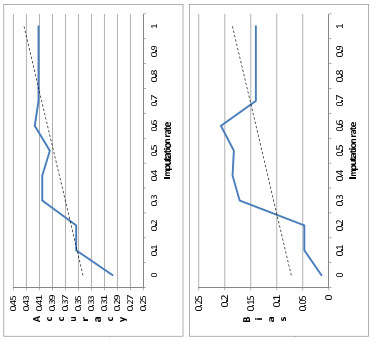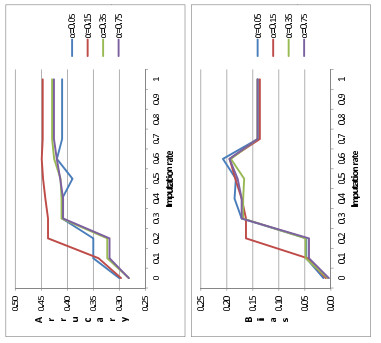A bias-variance dilemma in categorical data mining and analysis is the fact that a prediction method can aim at either maximizing the overall point-hit accuracy without constraint or with the constraint of minimizing the distribution bias. However, one can hardly achieve both at the same time. A scheme to balance these two prediction objectives is proposed in this article. An experiment with a real data set is conducted to demonstrate some of the scheme's characteristics. Some basic properties of the scheme are also discussed.
1.
Introduction
Fibonacci polynomials and Lucas polynomials are important in various fields such as number theory, probability theory, numerical analysis, and physics. In addition, many well-known polynomials, such as Pell polynomials, Pell Lucas polynomials, Tribonacci polynomials, etc., are generalizations of Fibonacci polynomials and Lucas polynomials. In this paper, we extend the linear recursive polynomials to nonlinearity, that is, we discuss some basic properties of the bi-periodic Fibonacci and Lucas polynomials.
The bi-periodic Fibonacci {fn(t)} and Lucas {ln(t)} polynomials are defined recursively by
and
where a and b are nonzero real numbers. For t=1, the bi-periodic Fibonacci and Lucas polynomials are, respectively, well-known bi-periodic Fibonacci {fn} and Lucas {ln} sequences. We let
In [1], the scholars give the Binet formulas of the bi-periodic Fibonacci and Lucas polynomials as follows:
and
where n≥0, σ(t), and τ(t) are zeros of λ2−abtλ−ab. This is σ(t)=abt+√a2b2t2+4ab2 and τ(t)=abt−√a2b2t2+4ab2. We note the following algebraic properties of σ(t) and τ(t):
Many scholars studied the properties of bi-periodic Fibonacci and Lucas polynomials; see [2,3,4,5,6]. In addition, many scholars studied the power sums problem of second-order linear recurrences and its divisible properties; see [7,8,9,10].
Taking a=b=1 and t=1, we obtain the Fibonacci {Fn} or Lucas {Ln} sequence. Melham [11] proposed the following conjectures:
Conjecture 1. Let m≥1 be an integer, then the sum
can be represented as (F2n+1−1)2R2m−1(F2n+1), including R2m−1(t) as a polynomial with integer coefficients of degree 2m−1.
Conjecture 2. Let m≥1 be an integer, then the sum
can be represented as (L2n+1−1)Q2m(L2n+1), where Q2m(t) is a polynomial with integer coefficients of degree 2m.
In [12], the authors completely solved the Conjecture 2 and discussed the Conjecture 1. Using the definition and properties of bi-periodic Fibonacci and Lucas polynomials, the power sums problem and their divisible properties are studied in this paper. The results are as follows:
Theorem 1. We get the identities
where n and m are positive integers.
Theorem 2. We get the identities
where n and m are positive integers.
As for application of Theorem 1, we get the following:
Corollary 1. We get the congruences:
and
where n and m are positive integers.
Taking t=1 in Corollary 1, we have the following conclusions for bi-periodic Fibonacci {fn} and Lucas {ln} sequences.
Corollary 2. We get the congruences:
and
where n and m are nonzero real numbers.
Taking a=b=1 and t=1 in Corollary 1, we have the following conclusions for bi-periodic Fibonacci {Fn} and Lucas {Ln} sequences.
Corollary 3. We get the congruences:
and
where n and m are nonzero real numbers.
2.
Proofs of theorems
To begin, we will give several lemmas that are necessary in proving theorems.
Lemma 1. We get the congruence
where n and m are nonzero real numbers.
Proof. We prove it by complete induction for j≥0. This clearly holds when j=0. If j=1, we note that abf3(2n+1)(t)=(a2b2t2+4ab)f32n+1(t)−3abf2n+1(t) and we obtain
This is obviously true when j=1. Assuming that Lemma 1 holds if j=1,2,…,k, that is,
If j=k+1≥2, we have
and
We have
This completely proves Lemma 1.
□
Lemma 2. We get the congruence
where n and m are nonzero real numbers.
Proof. We prove it by complete induction for j≥0. This clearly holds when j=0. If j=1, we note that al3(2n+1)(t)=bl32n+1(t)+3al2n+1(t) and we obtain
This is obviously true when j=1. Assuming that Lemma 2 holds if j=1,2,…,k, that is,
If j=k+1≥2, we have
and
We have
This completely proves Lemma 2.
□
Proof of Theorem 1. We only prove (1.3), and the proofs for other identities are similar.
□
Proof of Theorem 2. We only prove (1.7), and the proofs for other identities are similar.
□
Proof of Corollary 1. First, from the definition of fn(t) and binomial expansion, we easily prove (f2n+1(t)−1,a2b2t2+4ab)=1. Therefore, (f2n+1(t)−1,(a2b2t2+4ab)m)=1. Now, we prove (1.11) by Lemma 1 and (1.3):
Now, we use Lemma 2 and (1.5) to prove (1.12):
□
3.
Conclusions
In this paper, we discuss the power sums of bi-periodic Fibonacci and Lucas polynomials by Binet formulas. As corollaries of the theorems, we extend the divisible properties of the sum of power of linear Fibonacci and Lucas sequences to nonlinear Fibonacci and Lucas polynomials. An open problem is whether we extend the Melham conjecture to nonlinear Fibonacci and Lucas polynomials.
Use of AI tools declaration
The authors declare that they did not use Artificial Intelligence (AI) tools in the creation of this paper.
Acknowledgments
The authors would like to thank the editor and referees for their helpful suggestions and comments, which greatly improved the presentation of this work. All authors contributed equally to the work, and they have read and approved this final manuscript. This work is supported by Natural Science Foundation of China (12126357).
Conflict of interest
The authors declare that there are no conflicts of interest regarding the publication of this paper.














 DownLoad:
DownLoad: